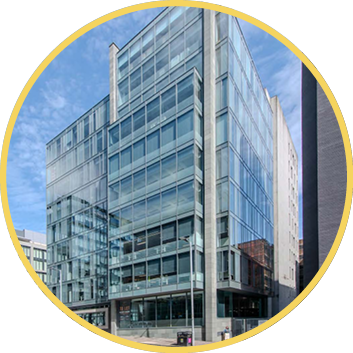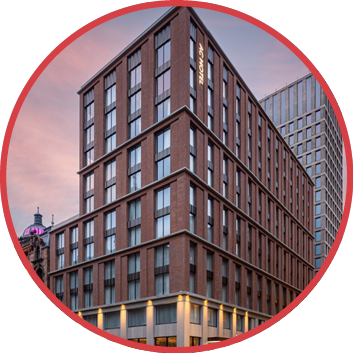
“We’ve only got half a dozen good bands in the UK. There’s Oasis and there’s five Oasis tribute bands…”
Noel Gallagher
Oasis isn’t the only comeback story of 2025. Perhaps not as high profile (or as eagerly awaited) but the prime city centre retail/leisure sectors in Glasgow and Edinburgh are seeing renewed investor appetite. A combination of attractive entry yields, reasonably robust tenant demand and rental growth are all combining to make the investment rationale more compelling.
The macro picture remains challenging as occupiers come to terms with the impact of the Government’s tax on employers but in many city centre blocks, rents have been re-based over the last 5 years, and we are starting to see some meaningful growth from these levels. Yields in the 6-7% bracket for prime stock are comparing well with historic lows and provide an attractive entry point, particularly if there is growth to come.
Vacancy levels on the key streets of Buchanan Street, Glasgow and George Street, Edinburgh are at virtually zero and Princes Street, Edinburgh at less than 10% and falling is further improving confidence that while there are some wider headwinds, the demand/supply balance remains positive.
With this backdrop, in addition to our wider market analysis, our focus this review will be looking at the city centre retail/leisure sectors. What is happening to pricing, what is driving investment rationale and how are mixed use blocks helping to stimulate activity in city centres. To help form our view, we are pleased to include a guest contribution from Nicola Barrett and Lisa Pollock from Lothian Pension Fund.
Noel Gallagher sang “Some might say we will find a brighter day” – in a rather dull market, the prime city centre retail/leisure sector is bringing a little light…

Market Overview.
Key Themes
Glasgow offices uptick – the momentum that we reported last quarter is continuing. Pricing has found its level and in addition to the French SCPIs (who have been prevalent for the last 24 months), new US and UK equity sources are seeing value and opportunity in the sector.
Rent controls – sense seems to be prevailing, with our politicians finally realising that if economic “growth” is to be stimulated then they need to create an investable environment and avoid further meddling to attract the substantial weight of capital waiting to be invested in the PBSA and BTR markets.
Aberdeen – true to form, the city is proving to be a classic contra-cyclical play. Volumes in the city’s office sector are likely to pass £130m in the last 12 months, surpassing both Edinburgh and Glasgow’s total volumes.
Further M&A activity – in the REIT sector, is leading to some rationalisation (and disposal) generally of smaller assets or holdings in non-core markets which don’t fit with the scale and strategic direction of the REIT.
UK Fund restructuring – two trends are relevant. (1) The “pooling” of smaller local Government pensions Funds (eg: Borders to Coast) leading to increased appetite for exposure to real estate and (2) the creation of hybrid real estate funds, with the aim of providing exposure to the UK property market but also to improve liquidity by investing in the Global REITs market. Some property selling is underway to be re-invested into REIT shares.
Transaction Volumes
Q3 saw £440m traded up 3% on Q3 2024
Q3 volumes were 12% above the 5 year average
Q3 2025 – Number of deals was 34
No Data Found
Our View
Whilst transaction volumes remained subdued in Q3, there are pockets of increased activity, particularly from core buyers looking for stable income from strong tenants and platform builders aggregating retail parks and industrial. Deepest investor demand continues to be for sub-£10m sales where there is either asset management potential or reversion in the short to medium term, with private investors, family offices and property companies seeing opportunity, particularly in the industrial and retail sectors.
The office sector has recorded both the largest transaction volume of any sector in Q3 totalling £133.5m and the biggest tally for the sector since Q3 2024. Much of this activity has been driven by investors targeting double digit yields with long term income to strong covenants and an increase in core plus and value add investors looking at comprehensive refurbishments. Whilst the French SCPI’s remain active, we have also seen a broad spectrum of buyers including pension funds, investment managers and property companies. Whilst buyer pools remain relatively thin, there has been a noticeable uptick in activity.
Despite numerous pressures on the leisure market including National Insurance and minimum wage hikes, occupational demand remains strong in Edinburgh and Glasgow. A combination of new national entrants and local restaurateurs expanding their footprints, is resulting in a vibrant leisure scene. A number of large city retail units which are no longer fit for purchase are currently being converted. With its unique views across Edinburgh’s Old Town, Princes Street has been the key beneficiary with the street now genuinely mixed use and competition for units back following 5+ years of decline.
Inflation remains persistently high at 3.8%, and the widely expected interest rate cuts in 2025 now appear likely to be delayed until 2026. While the upcoming Autumn Budget is not expected to deliver any major boosts for the commercial property sector, the broader economic challenges are increasingly being seen as background noise—still relevant, but no longer preventing many investors from moving forward after months of stasis.

Key Recent Transactions.
Q2 saw some interesting themes and significant transactions which we have highlighted below:

The Malt Portfolio
“Multi let industrial portfolio trades”
Vendor: CedarWood Asset Management
Purchaser: Northwood Urban Logistics
Let to: Multi Let
Price/Yield: £26m / c.7%
Date: August 2025

Quartermile 1, Edinburgh
“Off market office trades”
Vendor: Epic UK
Purchaser: BauMont Real Estate
& KZN Real Estate
Let to: Skyscanner, Addepar, Ofcom
Price/Yield: £53.85m / 6.85%
Date: August 2025

Sentinel, Glasgow
“Strathclyde Pension Fund acquire prime office”
Vendor: Ardstone Capital
Purchaser: Clydebuilt II c/o Ediston
Let to: DWF, JLL, Chubb, Aggreko, Sedgwick
Price: £19.60m / 8.6%
Date: September 2025

Martha Street Apartments, Glasgow
“U.S investor acquires city centre PBSA”
Vendor: Chris Stewart Group
Purchaser: Harbert Management Corporation
Let to: Direct-Let
Price: £58.5m / c.6%
Date: September 2025
The investor view on the high street retail market
With rents rebasing to more affordable levels and healthy occupier demand in certain prime locations, would you consider investing in high street retail?
No Data Found
Investor sentiment towards high street retail is cautiously positive, with 59% of respondents indicating they would consider investing. Appetite is strongest among propcos, 65% of whom expressed interest, followed by investment managers at 56%. By contrast, only half of funds said they would consider the sector, often citing the challenge of small lot sizes as a key barrier.
Many respondents stressed that opportunities would only be pursued in specific micro-locations. Only Scotland’s prime high streets among major cities such as Edinburgh and Glasgow would be of interest. Locations with rebased, more affordable rents and demonstrable tenant demand were seen as offering the greatest potential, while secondary and tertiary towns continue to attract less appetite.
Larger investors pointed to structural challenges, noting that high street assets can be too management intensive in comparison to their lot size. Institutional appetite in particular appears constrained by lot size, with smaller holdings considered immaterial and larger department store-type assets regarded as too risky except in exceptional cases.
While rebased rents have improved the investment case, the survey results suggest that activity will remain highly focused on prime, top-tier locations.
Over the next 12 months, do you believe prime high street yields are likely to harden, soften or remain stable?
No Data Found
Expectations for prime high street yields over the next 12 months are broadly stable, with 55% of respondents predicting no change. A further 41% expect yields to harden, while only 4% anticipate any softening. Among propcos, sentiment is evenly split between hardening and stability, reflecting a more confident outlook. By contrast, funds are markedly more cautious, with just 16% forecasting hardening, two-thirds expecting stability, and 16% anticipating some softening. Investment managers sit between these positions, with one-third predicting hardening and the majority leaning towards stability.
Several respondents suggested that yields are most likely to remain stable, with scope for selective hardening in only the very best locations. Others noted that economic uncertainty, particularly around government policy, taxation, and consumer spending, could act as a drag on performance and risk a modest softening in weaker scenarios. However, some highlighted that yields may tighten further given they are coming off a low base and supported by early signs of rental growth. Overall, the consensus is one of stability, with upside potential in prime, resilient assets tempered by broader macroeconomic headwinds.
Is mixed-use or pure retail/leisure the answer to creating vibrant high streets in prime city centres?
No Data Found
Investor opinion is overwhelmingly in favour of mixed-use as the key to creating vibrant high streets in Scotland’s prime city centres, with 93% of respondents preferring it to pure retail/leisure. This view is consistent across all investor types, with 86% of propcos, 83% of funds and 90% of investment managers agreeing.
The feedback provided by investors also emphasises that mixed-use must go beyond token gestures, with many highlighting the importance of introducing residential on upper floors to increase the number of people living in city centres and therefore underpin footfall for retail and leisure. Several respondents also noted that most towns and cities currently have an oversupply of retail space, making repurposing inevitable if high streets are to remain viable.
While mixed-use was seen as essential, respondents stressed that it cannot succeed in isolation: issues such as parking charges, poor shopping environments, planning constraints, and fragmented ownerships remain barriers to progress.
Overall, there is a strong consensus that mixed-use represents the way forward, but delivery will depend on supportive planning, investment, increased footfall in city centres and local authority action.
“Expert view” on high street retail…

Nicola Barrett
Fund Manager
Lothian Pension Fund

Lisa Pollock
Property Asset Manager
Lothian Pension Fund
There’s been a noticeable uptick in high street retail investment activity over the past 18 months, what do you think are the key drivers of that?
We’ve seen retail investment pick up for a few key reasons. First, pricing has become attractive relative to other sectors like logistics, so investors are finding better value. Second, stable income and some rental growth prospects. Vacancy rates have continued to tighten in prime locations creating competition with retailers aggressively bidding to secure sites. Low insolvency, lots of new entrants into the market and physical retail remaining a core component of occupiers’ business strategies, have all helped drive tangible rental growth. For good assets in strong locations down time from voids is likely to be short lived and with income remaining the key driver of returns, that makes investment in the sector attractive.
What’s the key to keeping high streets in core cities vibrant, does mixed-use play a big role, or does it depend on the location? i.e. Princes Street versus Buchanan Street
The key to keeping high streets vibrant is making them destinations, not just shopping streets. That means the right mix of retail, leisure, hospitality, and culture, so people have multiple reasons to visit and stay. Mixed-use definitely plays a big role in many locations — offices, residential, and even hotels can all help drive consistent footfall. But it’s not one-size-fits-all: on a street like Princes Street, the opportunity may be more about repurposing and introducing new uses, while on Buchanan Street the strength of prime retail is still the anchor, supported by complementary uses around it. Public sector engagement is also a significant factor.
Which parts of the high street retail market are seeing rents pushing on, and do you think that growth will spread beyond the prime streets or stay very micro-location specific?
We’re seeing rental growth come through most strongly on the very prime, high-footfall streets and in dominant shopping centres where demand is deepest. Retailers are willing to compete for the best space, so rents are edging up there. But it’s still very micro-location specific — growth isn’t uniform, and secondary locations are under more pressure. Over time, we could see it spread selectively to strong regional hubs, but for now it’s the best-in-class assets that are capturing that rental uplift.
How does rental growth in your Scottish high street retail assets compare against those in England?
Very hard comparison to make since this is very asset specific. More generally London luxury streets like Bond, Sloane and Regent Streets are seeing the strongest rental growth nationally due to tourism and luxury spending. Whilst England’s very top luxury locations are driving stronger growth than Scotland’s, Buchanan Street is holding its own and outperforming regional centres.
Do you see more investment opportunities emerging in the UK’s top retail spots as we head into the second half of the year?
Perhaps if owners consider now an optimum time to capitalise on markets with strong occupational demand and opportunity for rental growth. However, supply is constrained as few genuinely prime assets trade. Institutions have been the main sellers but if strategies change then opportunities may be thin on the ground.
On new lettings, retail landlords have traditionally benefitted from low capex requirements and relatively minimal incentives, do you think that’s still a big draw for investors?
Absolutely, low capex and lower incentives have made retail more attractive than other sectors. Typically let out on a shell and core basis occupiers will fit out themselves particularly in strong retail parks or sought after High Streets. This story is however changing for secondary locations where there are rising incentives, costly landlords works and longer voids. For investors the appeal is strongly weighted towards resilient assets in prime locations.
Do you expect your property fund allocations to stay steady, or could we see an increase as real estate becomes more attractive?
We like the asset class and will grow the real estate portfolio. We’re deliberately unconstrained in terms of sector allocations so this will be very much on an opportunity led basis.

